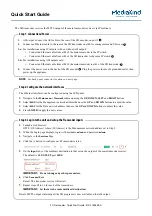
Confidential
Chapter
3
Connecting
Cables
RF4402d Series Installation Manual v1.0
63
Copyright © 2018, All Rights Reserved.
The cable must be placed in a location where it will not be damaged by
external factors (power line, flooding, footpaths, and so on).
In areas where the cable may be damaged by external factors, ensure that
measures are taken to prevent damage to the cable (cable tray, ducts, flexible
pipe, and so on).
Cable Cutting
Measure the exact distance, carefully checking the route, and cut the cable using a
cutting tool.
Follow these guidelines when cutting the cable.
Cut the cable to the length determined in the Cable Path Inspection step.
Use a dedicated cable cutting tool.
Cut the cable at right angles.
Be careful to keep the cable away from any moisture, iron, lead, dust, or other
foreign material when cutting.
Remove any foreign material attached to the cable using solvent and a brush.
Cable Installation
Cable installation involves running the cable along the cabling path to the target
connector of the system or an auxiliary device after cable path inspection and cable
cutting have been completed.
Follow these guidelines when installing a cable:
Be careful not to damage the cable.
If the cable is damaged, cut out the damaged section before installing, or
replace the cable.
Run the cable so that it is not tangled. In particular, when installing a cable
from a horizontal section to a vertical section, be careful not to reverse the
upper and lower lines of the cable.
Always use the maximum curvature radius possible, and make sure that the
minimum curvature radius specification is complied with.
If the cable needs to be protected, use for example, a PVC channel, spiral
sleeve, flexible pipe, cable rack, and so on.
Install the DC power cable and data transmission cable away from the AC
power cable to prevent electromagnetic induction.
Table 22. Recommended Minimum Allowed Cable bend Radius
No
Type
Allowed Cable Bend Radius
1
Ground Cable
8 × Outer Diameter (OD)
2
AC Power Cable
10 × OD
















































